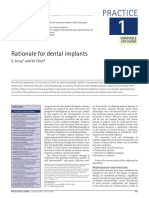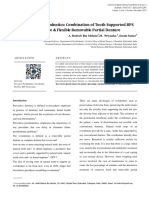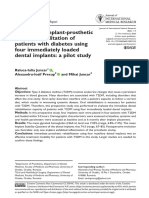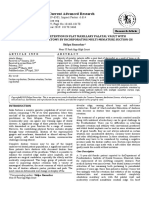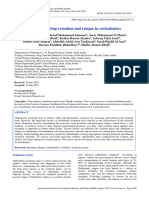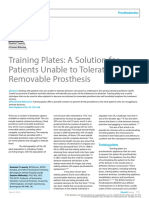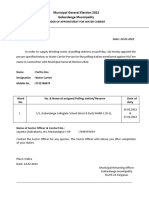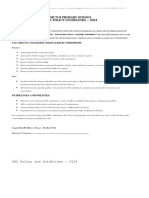Implant-Supported Overdentures: Part 1: Clinical
Implant-Supported Overdentures: Part 1: Clinical
Uploaded by
DhanasriCopyright:
Available Formats
Implant-Supported Overdentures: Part 1: Clinical
Implant-Supported Overdentures: Part 1: Clinical
Uploaded by
DhanasriOriginal Title
Copyright
Available Formats
Share this document
Did you find this document useful?
Is this content inappropriate?
Copyright:
Available Formats
Implant-Supported Overdentures: Part 1: Clinical
Implant-Supported Overdentures: Part 1: Clinical
Uploaded by
DhanasriCopyright:
Available Formats
CLINICAL Prosthodontics
Implant-supported overdentures: part 1
David Gray1 and Jaymit Patel*1
Key points
Outlines the various types of implant-supported Provides simple guidance on the advantages, Highlights the role of implant-supported
overdentures. disadvantages and treatment planning challenges overdentures and provides an update on the
when considering implant-supported overdentures. commonly available implant attachment systems.
Abstract
The ability to provide high-quality complete dentures is a key skill for the GDP. The increasing prevalence and
utilisation of implant-supported overdentures has opened the possibility of a wide variety of treatment options
to support patient care, while also creating the need for primary care practitioners to have a greater awareness of
commonly used prosthetic attachments.
A thorough understanding of the advantages and disadvantages of implant-supported overdentures is essential to
ensuring appropriate treatment planning, consent and maintenance. This two-part series explores various aspects
of implant-supported overdentures including assessment of the patient, treatment planning, different attachment
systems and maintenance requirements.
Part one will explore availability of implants in the NHS, the commonly available implant attachment systems,
including their relative advantages and disadvantages.
Introduction Complete dentures have been successfully While the complete denture remains the
used to rehabilitate edentulousness for most common treatment for edentulism, it is
This article is the first in a two-part series centuries. However, they were historically not without significant shortcomings. Many
exploring the treatment options, planning far more prevalent then they are now, and as complete denture wearers report difficulties
considerations and maintenance requirements such, rather than being a regular treatment, in chewing a variety of foods.3,4 Furthermore,
for implant-supported overdentures (ISODs). it is something that many practitioners will there may be a significant psychological
Part one describes ISODs, their relative encounter with increasing rarity (Table 1). impact of wearing complete dentures,5 which
advantages and disadvantages, and the implant Patients’ attitudes to dental treatment are may impact upon confidence and social
attachment systems available commercially. also changing, with a more positive attitude participation. Consequently, the McGill 6
Part two will focus on the treatment planning towards dental health, an increased desire to and York7 consensus statements (published
of ISODs, including the diagnostic process, the avoid dental extractions and an increasingly in 2002 and 2009, respectively) suggested
optimal number and distribution of implants, negative opinion of complete conventional that the two-implant-supported overdenture
planning the implant-supported prosthesis, dentures.2 Increasing demands for improved should be the first-choice standard for
as well as the long-term maintenance function and fixed tooth replacement, restoration of the edentate mandible.
requirements. alongside the increasing availability of implant Research to support this has highlighted
‘For many patients, being edentulous must treatments, have led to greater uptake of the influence that a two-implant-supported
be regarded as a handicap with respect to oral dentures which utilise implants for retention overdenture can have on oral health-related
function and psychosocial impact on quality and support. quality of life (OHRQoL).6,7
of life’.1
Table 1 Proportion of edentate adults (1978–2000)
1
Leeds Dental Institute, The Worsley Building, Clarendon All adults
Way, LS2 9LU, UK.
*Correspondence to: Jaymit Patel
England and Wales England
Country
Email address: jaymit.patel@nhs.net
Percentage edentate
Refereed Paper.
Year of survey 1968 1978 1988 1998 2009
Accepted 3 December 2020
https://doi.org/10.1038/s41415-021-3224-4 Prevalence 37% 29% 20% 13% 6%
94 BRITISH DENTAL JOURNAL | VOLUME 231 NO. 2 | July 23 2021
© 2021 The Author(s), under exclusive licence to British Dental Association
Prosthodontics CLINICAL
While considered an excellent treatment
Table 2 The reported incidence of implant failure
option, ISODs may not be appropriate in all
cases. As such, implant planning is complex Arch/prosthesis Mean incidence
and must consider multiple variables
Maxillary overdentures 19%
including the number of fixtures, whether or
not to splint implants and how to utilise the Maxillary fixed complete dentures 10%
implants to retain or support a denture. Thus, Maxillary fixed partial dentures 6%
thorough patient assessment and planning
Mandibular fixed partial dentures 6%
stages are essential.
Mandibular overdentures 4%
Implants in the NHS Mandibular fixed complete dentures 3%
Maxillary and mandibular single crowns 3%
Implant provision within the NHS is guided by
a document produced by the Royal College of
Surgeons England.8 This document identifies improving comfort and taste by allowing a a prosthesis.12,22 Furthermore, patients often
that, due to a lack of clarity in previous reduction in palatal coverage.10,11,12 present with severely resorbed alveolar bone
documents, access to implant supported An ISOD confers a significant improvement in the posterior maxilla, and practitioners may
rehabilitations varied significantly across in biting force and chewing efficiency.13,14 struggle to accommodate for idealised implant
different NHS services. Thus, it presented Furthermore, this improved oral function number, distribution and length.21 Some
clearer criteria outlining which patient groups has been shown to remain stable over time.15 authors suggest that the resulting compromises
may be considered for access to implant However, the ability to eat a wider range may explain the higher failure rate of maxillary
treatments. This included: of foods has not been shown to result in an implant supported dentures reported in the
1. Patients with developmental conditions improved dietary intake.14 literature.23,24,25 However, survival rates for
leading to tooth loss or malformed teeth ISODs have also been shown to improve implants supporting maxillary ISODs vary
2. Patients with traumatic events leading to speech and confer other psychological benefits, widely in the literature: ranging from 72.4% to
tooth loss including increased self-confidence, improved 100%.20,26,27,28
3. Patients who have undergone surgical social interaction, emotional wellbeing and The theoretical reasons for lower implant
interventions resulting in tooth and tissue overall quality of life.16,17,18 survival in the maxilla may relate to the
loss; for example, head and neck cancer and It is important to note that prosthetically distribution of forces through “softer” bone. An
non-malignant tumours driven implant positioning/placement remains ISOD will exert linear forces on the abutments
4. Patients with congenital or acquired essential to the feasibiltiy of ISODs. Failure to in apical and coronal directions as well as
conditions with extraoral defects of, for achieve this may prevent utilisation of implants rotational/torsional forces associated with
example, eyes or ears to retain a denture.19 attachment configuration, implant distribution
5. Patients who are edentulous in either one An ISOD facilitates greater access for oral and prosthesis instability. These forces are
jaw or both, in whom repeated conventional hygiene when compared to fixed implant distributed through the implant screws,
denture treatment options have been bridges. 20 The ability to easily remove superstructure and bone-implant interface
unsuccessful. In such instances, the quality the prosthesis is also advantageous when through a complex array of compression,
of previous dentures must be assessed by a examining the oral tissues, particularly in torsional and tensile interactions.
consultant in restorative dentistry individuals with a high risk of oral cancer. Furthermore, the patient must contend with
6. Patients with severe oro-mucosal disorders the possibility of treatment complications
and those with severe xerostomia where The challenges of implants and an and failures including peri-implantitis, an
conventional prosthetic treatment implant-supported overdenture increased prevalence of denture complications
is not possible and/or the provision including fracture and the risk of early or late
of conventional treatment would be ISODs have numerous disadvantages over implant failure. Table 2 summarises implant
detrimental to the mucosal disorders conventional dentures. The most obvious is the failure rates in the mandible and maxilla when
7. Patients who do not have suitable existing need to undergo implant surgery, which may coupled with different implant restorations;
teeth that can be used for anchorage to involve multiple surgical procedures especially the implant-supported maxillary denture is
facilitate orthodontic treatment. in cases where bone grafting is required. ISODs reported to be associated with the highest
also create an increased demand for prevention implant failure rate.
The advantages of an implant- and maintenance in a cohort of patients who Fur thermore, implant supp or ted
supported overdenture have historically been unable to maintain their rehabilitations require more frequent
dentition. maintenance appointments when compared to
ISODs are an effective, predictable and reliable While evidence identifies good outcomes a conventional denture. This requirement is the
treatment option, often indicated in cases with mandibular ISODs,21 implant treatment result of the need to maintain dental implants
where the prosthesis has suboptimal retention in the maxilla can be more challenging owing as well as the attachment systems to optimise
and stability and for those with a prominent to the poorer bone quality in this region and peri-implant health, denture retention and
gag reflex.9 ISODs improve retention, while thus the need for more implants to support denture lifespan.
BRITISH DENTAL JOURNAL | VOLUME 231 NO. 2 | July 23 2021 95
© 2021 The Author(s), under exclusive licence to British Dental Association
CLINICAL Prosthodontics
Attachment systems Fig. 1 Types of implant attachment system for ISODs
There are many different attachments provided
Locator attachments
by a multitude of manufacturers. Each system is
comprised of two parts. One part attaches to the
Free-standing Ball and socket
implant directly (the abutment) and the other
to the prosthesis (the housing and retentive
insert). The implants can be splinted with a bar Magnet attachments
or can be free-standing. Some of the available
Hader bar system
attachment systems are summarised in Figure 1. Direct retained
Attachments can also be described as rigid or Dolder bar system
resilient. Rigid attachments theoretically allow
no movement of their components in function29 Locator bar attachments
and these include bars. In practice, small Splinted (bar) Incorporated into the bar
movements do occur, this being a reflection of Clix bar attachments
component wear. Resilient attachments allow
a pre-calculated amount of movement,29 and
Offset attachments Plunger Loc or Vertix
include clips, ball attachments and locators.
This movement serves to distribute potentially
harmful forces.
The removable prosthesis can be described as
implant-retained or implant-supported. While
these terms are often used interchangeably, they
have distinct differences. An implant-retained
overdenture is retained by the attachment
system but supported by the underlying soft
tissues. Conversely, an implant-supported
overdenture is supported in its entirety by the
implants, without loading of the underlying soft
tissues. This difference influences the techniques
used when constructing the prosthesis. An
implant-retained prosthesis requires careful
impression taking to ensure accurate recording
of the supporting soft tissues in a passive/
undisplaced state. Failure to achieve this could
result in more rapid implant component
wear. This concept is similar to the notion of
combined tooth and tissue support with distal
extension mandibular dentures.
Assuming the commonly adopted
categorisation of splinted versus free-standing,
each group has many subcategories with
different commercially available products. Fig. 2 Locators incorporated into a custom bar, images courtesy of John Wood, Dental
This section will aim to cover some of the Technician, Leeds Dental Institute
considerations for deciding upon which to
utilise, although it is important to note that
which attachment is used is based largely on complexity to the treatment plan in that they 3. Offset attachments, such as the Plunger Loc
opinion and anecdotal experience rather than increase cost, have greater prosthetic space or Vertix.
on research supported evidence.30 requirements and require a higher level of
dexterity for the patient to clean. Offset attachments are rarely used due to
Splinted attachments Bars come in various shapes and can be their inherent mechanical disadvantages,
Bars are a method of splinting multiple designed with a multitude of attachment relative complexity and limited benefit over
implants. They connect to multiple implants systems: alternative options. Hader and Dolder bars are
and help to distribute forces across a larger 1. Direct retainers, such as the Hader or relatively simple and require the least prosthetic
area. This can be particularly advantageous in Dolder systems space for splinted attachments; however, they
certain circumstances, for example zygomatic 2. Bars with secondary attachments (such as offer few means of customisation. Locators
implants. Bars can, however, introduce Locator attachments) (see Figure 2) and Clix attachments added to a bar require
96 BRITISH DENTAL JOURNAL | VOLUME 231 NO. 2 | July 23 2021
© 2021 The Author(s), under exclusive licence to British Dental Association
Prosthodontics CLINICAL
greater space, but offer the broadest range of
maintenance options. Advantages include:
1. The retentive inserts and housings are often
easier to replace and offer a wider range
of retentive strengths (for example, if a
Locator system is used)
2. The secondary attachment can be designed
such that removal and replacement of this
component alone is possible
3. The bar itself can have a more angular
profile, thus offering greater support for
the denture.
Bar size and shape is dictated by the
space available, the ridge shape and the type
of prosthesis. The use of bars is one of the
few instances where conventional denture
construction principles are altered – the
clinician should not engage labial soft tissue
undercuts with the denture flanges as this alters
the path of insertion, which in turn can lead to
excessive wear of the components.
Bar-retained ISODs demonstrate good
retention and stability, especially in the case
of flat posterior ridges, where they provide
better transversal support and stability of the
prosthesis. Although the retentive elements
require replacement over time, the literature Fig. 3 A locator assembly consisting of the locator abutment (gold with silver screw) and
suggests that bar constructions require less locator inserts. The locator inserts are retained within the locator housing (silver cap). Locator
inserts are replaced using the locator tool (right) – the topmost section of this is used to
frequent maintenance compared to free-
remove old inserts; this is then unscrewed and the underlying component is used to place new
standing attachments.31 These may, however, inserts
be costlier to replace if the bar itself becomes
worn, with studies suggesting that the wear
rate of noble alloy bars exceeds that of many Bar construction designs require a minimum However, there is evidence that the
free-standing abutments.32 This is particularly inter-implant distance of 10–12 mm to enable retention forces of ball attachments and
the case when the shape of the bar itself positioning of the retentive attachment locators decrease significantly over time, and
contributes to the retention of the prosthesis. element. Implants positioned too far distally locator inserts require regular review.34 This
The replacement of bars can be costly and time- lead to the bar traversing the floor of the increased maintenance effort is a time and cost
consuming. This was historically the case when mouth and subsequently to food impaction commitment for the dentist and patient.
the majority of bars were cast, often with a high and interference with tongue movement. There are three commonly used free-
noble alloy. This process was prone to error standing attachment systems: Locator
due to the dimensional changes that occur as Free-standing attachments attachments, ball attachments and magnets.
cast metal bars cool. This commonly resulted Dentures utilising free-standing attachments
in bar misfit and thus necessitated sectioning are implant-retained, and are partly tissue- Locator attachments
and soldering of the bar to achieve a passive fit. supported. These can be incorporated into Locator attachments are produced by Zest
The advent of computer aided milling has new prostheses or cold-cured into an existing Dental Solutions (California, USA). The
overcome some of the challenges associated prosthesis of satisfactory technical quality. Locator overdenture attachment is compatible
with casting large metal bars. Concerns still The advantage of free-standing attachments with many implant systems and has become
remain relating to bar passivity. is that all implant components are preformed widely used in the United Kingdom. It consists
Bars are more challenging for patient rather than being custom-made, often of a Locator abutment, a denture housing and
cleaning regimes. Published literature resulting in a cost saving. This also forgoes a retentive insert (Fig. 3).
reports higher plaque accumulation, the need for an expensive custom-made bar Locator abutments are available in varying
resulting in a higher incidence of peri- and utilises standardised components. As heights between 1 mm and 6 mm. These
implant mucositis. 31,33 Although it might these attachments have no primary splinting, correspond to the soft tissue height which is
be noted that this has not translated into a cleansability is improved, particularly in measured from the implant fixture/prosthetic
higher incidence of peri-implantitis or lower cases where the patient has reduced manual platform to the highest adjacent soft tissue
implant survival.31 dexterity. level. The housing is embedded into the
BRITISH DENTAL JOURNAL | VOLUME 231 NO. 2 | July 23 2021 97
© 2021 The Author(s), under exclusive licence to British Dental Association
CLINICAL Prosthodontics
socket systems are simple to use and provide
excellent retention.
Their primary disadvantage is the inability
to accommodate inter-implant angulations
of more than 15 degrees (compared to 60
degrees with Locator attachments).
Furthermore, various studies32,38,39,40 have
highlighted concerns with wear of ball
abutments over time. This, coupled with a
tendency for ball abutments to historically
cold-weld into internal-hex implant fixtures,
can lead to difficulty removing ball abutments.
Where possible, ball abutments are replaced
with Locators to prevent recurrence of such
difficulties.
Fig. 4 Implant-supported overdenture with two locators, image courtesy of John Wood, Dental
Technician, Leeds Dental Institute Magnets
Magnet systems consist of a magnetic
abutment and the denture-housed magnet.
denture, either during denture construction or can reportedly accomodate inter-implant Most systems offer a variety of lengths
utilising a chairside reline/pick-up technique angulations of up to 60 degrees. depending on soft tissue height and varying
(Fig. 4). The retentive inserts fit within the Locator abutments require minimal strengths of magnets.
denture housing and are easily interchangable vertical space and may be considered non- Magnets are typically used in patients
depending on the level of retention desired. intrusive for the patient when the denture with reduced manual dexterity for whom
The retentive component wears and requires is not in situ. This low profile is also of other systems are too difficult to insert or
regular replacement (notably when the significant benefit where there is limited remove. In contrast to bars, balls or Locators,
denture begins to lose retention). Fortunately, prosthetic space to accommodate implant magnet retained dentures have some ability
problems with Locator retained dentures are attachments. Only 3 mm of space is required to ‘self-locate’ over a short distance. Patient
usually simple to resolve chairside.35 to incorporate the Locator housing into the placement of the denture therefore does not
Inter-implant angulations can influence denture. It is, nonetheless, important to need to be as precise.
the ability of retentive components to marry assess the occlusion with dentures removed, Magnets may also be used in cases of
successfully and poor angulations can either as premature occlusal contact can result reduced inter-arch space, and their simple
cause rapid component wear or result in a in rapid wear of Locator abutments and design means that they are considered easier
failure of the prosthesis to seat. 36,37 The complicate retrieval if the triangular intra- to clean as they lack significant undercuts.
Locator system includes an ‘extended range’ abutment key is damaged (Fig. 5). However, while they have clear uses,
of Locator inserts which facilitate retention magnets are the least retentive attachment
with higher inter-implant angulations of 40 Ball and socket system and may lose their retentiveness
degrees, compared to 20 degrees with the Ball attachments are fitted into the implant further over time, consequently requiring
standard range of inserts. This accommodates fixture, with the corresponding housing further maintenance. There have also
greater inter-implant angulations than (also known as socket or anchor) embedded been reported issues with older magnet
ball attachments. Additionally, Locator into the prosthesis. The housing distorts on attachments corroding 41 and reports that
attachments are also available as part of insertion of the prosthesis to engage into the some magnet abutments may interfere with
a newly introduced ‘R-Tx’ system which undercuts of the ball/stud abutment. Ball and MRI imaging.42,43
Fig. 5 a) Worn Locator abutments. b) Traumatic occlusion. c) Replacement Locator abutment
98 BRITISH DENTAL JOURNAL | VOLUME 231 NO. 2 | July 23 2021
© 2021 The Author(s), under exclusive licence to British Dental Association
Prosthodontics CLINICAL
How different attachment types result in marginal bone loss.46 Nonetheless, Conclusion
may influence the outcome no differences in peri-implant health
or bone levels have been reported when The prevalence of edentulousness is falling.
The clinical design of implants and their comparing free-standing and splinted Patients may transition to complete dentures
superstructures will impact both implant implants. 31 Another systematic review at a later age, and thus may have a reduced
survival, peri-implant outcomes, patient and meta-analysis of the literature, which adaptive capacity.52
satisfaction and prosthetic maintenance. investigated outcomes from 4,200 implants As such, increasing age results in a reduction
from 13 manufacturers, found there was no in the adaptive neuromuscular capacity
Implant survival difference in marginal bone loss attributable required for successful denture wear. This
Theoretically, splinting implants can to ISODs with different implant attachment creates a challenge for dental practitioners53
result in more favorable distribution of designs.47 and increases the importance of creating
forces through the implant-bone interface. high-quality prostheses that reduce adaptive
Contradictory to this, one systematic review Patient satisfaction and prosthetic requirements.
of studies involving follow-ups of more than maintenance The relative lack of literature, particularly
three years showed no difference in implant Many studies report no significant difference with regards to maxillary rehabilitation,
survival between splinted and unsplinted in patient satisfaction when ISODs are remains a challenge, as many assumptions
design. 31 Two further systematic reviews constructed with splinted or free-standing must be extrapolated from data pertaining
investigating maxillary ISODs corroborated implant attachments.31,48 There is, however, an principally to the mandible.
these findings, reporting no statistical association between lower patient satisfaction In the maxilla, complete dentures are and
difference in implant survival between the and the need for more frequent prosthetic will remain the mainstay of treatment for
splinted and unsplinted groups. 12,44 While maintenance as a result of attachment wear the vast majority of edentulous patients.54
there is theoretical mechanical advantage and corrosion. 30 There is some published High-quality complete maxillary dentures are
to splinting dental implants, the need to literature to suggest that magnet-retained associated with far fewer of the shortfalls of
splint implants should be based on the overdentures are associated with lower their mandibular counterparts and have been
characteristics of each case, including: patient satisfaction than other attachment shown to routinely exceed expectations,55,56
• The number, size and distribution systems.49 provide satisfactory oral and masticatory
of implants (for example, zygomatic While prosthetic complications with function,57,58 and effectively improve quality
implants where the prosthetic platform is ISODs are unavoidable, there is no of life.59 For individuals unable to adapt to a
a considerable distance from the implant- robust evidence for the superiority of conventional denture, an implant-retained
bone interface, short or narrow implants one attachment design over another with and/or implant-supported denture offers a
with reduced bone-implant contact or regards to prosthetic maintenance and potential alternative.
cases with poor-quality bone) outcomes,47,50although one review reported In the mandible, there is overwhelming
• The anticipated occlusal loads (for that bar-supported overdentures require evidence to support the provision of a two-
example, individuals with a history of fewer prosthetic maintenance appointments implant supported overdenture as the first
multiple mechanical prosthetic failures) in the short term.31 choice rehabilitation. Unfortunately, there
• The need for implants to provide denture are still barriers that need to be overcome for
support (for example, cleft or oncology Limitations of the evidence base the delivery of this care to benefit edentulous
defects). patients.7
While mandibular implants and their While many general dental practitioners
Additionally, there is evidence to suggest sup erst r uc tures have b e en w idely may not be routinely placing and restoring
that soft tissue-supported dentures result investigated published research investigating implants, their maintenance, especially with
in increased bone loss beneath the denture ISODs in the edentate maxilla is sparse. systems such as Locator attachments, is likely
bearing mucosa.45 An implant bar-supported Many systematic reviews of implant to become more prevalent and incorporated
denture will reduce the magnitude of such sur vival in the maxilla have found within routine dental care.
forces through the soft tissues, thus reducing insufficient literature to recommend
the need for denture relines and remakes ideal implant numbers or positions in the Conflict of interest
associated with volumetric changes of the arch. 22,31 Published reviews cite a dearth The authors declare no conflicts of interest.
oral tissues. of randomised controlled trials investigating
this.20 References
Peri-implant outcomes and marginal For example, a systematic review found 1. Mericske-Stern R, Taylor T, Belser U. Management of
bone loss 26 studies related to mandibular ISODs, yet the edentulous patient. Clin Oral Implants Res 2000;
11(Suppl 1): 108–125.
While splinted implants may be associated only one assessing OHRQoL changes related 2. Bradnock G, White D A, Nuttall N M, Morris A J,
with peri-implant mucositis as a result of to maxillary ISODs,51 with this study having Treasure E T, Pine C M. Dental attitudes and behaviours
in 1998 and implications for the future. Br Dent J 2001;
more challenging cleaning and increased a small sample size. 190: 228–232.
plaque retention, free-standing implants Thus, it would be beneficial for future 3. Wayler A, Chauncey H. Impact of complete dentures and
impaired natural dentition on masticatory performance
may result in more harmful forces at the research to focus on longer-term outcomes and food choice in healthy aging men. J Prosthet Dent
bone-implant connection and thus may and maxillary ISODs. 1983; 49: 427–433.
BRITISH DENTAL JOURNAL | VOLUME 231 NO. 2 | July 23 2021 99
© 2021 The Author(s), under exclusive licence to British Dental Association
CLINICAL Prosthodontics
4. Hartsook E. Food selection, dietary adequacy, and 23. Jemt T, Book K, Lindén B, Urde G. Failures and retention loss of ball attachment systems in implant-
related dental problems of patients with dental complications in 92 consecutively inserted overdentures retained overdentures: An in vitro study. Clin Implant
prostheses. J Prosthet Dent 1974; 32: 32–40. supported by Brånemark implants in severely resorbed Dent Relat Res 2018; 20: 778–784.
5. Papadaki E, Anastassiadou V. Elderly complete denture edentulous maxillae: a study from prosthetic treatment 41. Boeckler A F, Ehring C, Morton D, Geis-Gerstorfer J,
wearers: a social approach to tooth loss. Gerodontology to first annual check-up. Int J Oral Maxillofac Implants Setz J M. Corrosion of dental magnet attachments
2012; DOI: 10.1111/j.1741-2358.2011.00550.x. 1992; 7: 162–167. for removable prostheses on teeth and implants.
6. Feine J S, Carlsson G E, Awad M A et al. The McGill 24. Jemt T. Implant treatment in resorbed edentulous upper J Prosthodont 2009; 18: 301–308.
consensus statement on overdentures. Mandibular two- jaws. Clin Oral Impant Res 1993; 4: 187–194. 42. Chockattu S J, Suryakant D B, Thakur S. Unwanted
implant overdentures as first choice standard of care for 25. Jemt T, Chai J, Harnett J et al. A 5-year prospective effects due to interactions between dental materials
edentulous patients. Gerodontology 2002; 19: 3–4. multicentre follow-up report on overdentures supported and magnetic resonance imaging: a review of the
7. Thomason J M, Kelly S A M, Bendkowski A, Ellis J S. by osseointegrated implants. Int J Oral Maxillofac literature. Restor Dent Endod 2018; DOI: 10.5395/
Two implant retained overdentures – a review of the Implants 1996; 11: 291–298. rde.2018.43.e39.
literature supporting the McGill and York consensus 26. Bergendal T, Engquist B. Implant-supported 43. Mathew C A, Maller S, Maheshwaran. Interactions
statements. J Dent 2012; 40: 22–34. overdentures: a longitudinal prospective study. Int J Oral between magnetic resonance imaging and dental
8. Darbar U, Shahdad S, Ashley M et al. Guidance on Maxillofac Implants 1998; 13: 253–262. material. J Pharm Bioallied Sci 2013; 5(Suppl 1):
the standards of care for NHS-funded dental implant 27. Widbom C, Söderfeldt B, Kronström M. A retrospective S113–S116.
treatment. London: Royal College of Surgeons of evaluation of treatments with implant-supported 44. Di Francesco F, De Marco G, Sommella A, Lanza A.
England, 2019. maxillary overdentures. Clin Implant Dent Relat Res Splinting vs Not Splinting Four Implants Supporting
9. Visser A, Raghoebar G M, Meijer H J A, Vissink A. 2005; 7: 166–172. a Maxillary Overdenture: A Systematic Review. Int
Implant-retained maxillary overdentures on milled bar 28. Hutton J, Heath M, Chai J et al. Factors related to success J Prosthodont 2019; 32: 509–518.
suprastructures: a 10-year follow-up of surgical and and failure rates at 3-year follow-up in a multicentre 45. Carlsson G E. Responses of jawbone to pressure.
prosthetic care and aftercare. Int J Prosthodont 2009; study of overdentures supported by Brånemark Gerodontology 2004; 21: 65–70.
22: 181–192. implants. Int J Oral Maxillofac Implants 1995; 10: 33–42. 46. Misch C E. Dental implant prosthetics. St Louis: Elsevier
10. Dudley J. Maxillary implant overdentures: current 29. Williams G, Thomas M, Addy L D. Precision attachments Health Sciences, 2015.
controversies. Aust Dent J 2013; 58: 420–423. in partial removable prosthodontics: an update for the 47. Çehreli M C, Karasoy D, Kökat A M, Akça K, Eckert S.
11. Cavallaro J, Tarnow D. Unsplinted Implants Retaining practitioner part 1. Dent Update 2014; 41: 725–731. A Systematic Review of Marginal Bone Loss Around
Maxillary Overdentures with Partial Palatal Coverage: 30. Trakas T, Michalakis K, Kang K, Hirayama H. Attachment Implants Retaining or Supporting Overdentures. Int
Report of 5 Consecutive Cases. Int J Oral Maxillofac systems for implant retained overdentures: a literature J Oral Maxillofac Implants 2010; 25: 266–277.
Implants 2007; 22: 808–814. review. Implant Dent 2006; 15: 24–34. 48. Wismeijer D, Van Waas M A, Vermeeren J I, Mulder J,
12. Sadowsky S. Treatment considerations for maxillary 31. Stoumpis C, Kohal R. To splint or not to splint oral Kalk W. Patient satisfaction with implant-supported
implant overdentures: A systematic review. J Prosthet implants in the implant‑supported overdenture mandibular overdentures. A comparison of three
Dent 2007; 97: 340–348. therapy? A systematic literature review. J Oral Rehabil treatment strategies with ITI-dental implants. Int J Oral
13. Rismanchian M, Bajoghli F, Mostajeran Z, Fazel A, 2011; 38: 857–869. Maxillofac Surg 1997; 26: 263–267.
sadr Eshkevari P. Effect of Implants on Maximum Bite 32. MacEntee M I, Walton J N, Glick N. A clinical trial of patient 49. Burns D R, Unger J W, Elswick Jr R K, Giglio J A.
Force in Edentulous Patients. J Oral Implantol 2009; 35: satisfaction and prosthodontic needs with ball and bar Prospective clinical evaluation of mandibular implant
196–200. attachments for implant-retained complete overdentures: overdentures: Part II – Patient satisfaction and
14. Boven G C, Raghoebar G M, Vissink A, Meijer H J three-year results. J Prosthet Dent 2005; 93: 28–37. preference. J Prosthet Dent 1995; 73: 364–369.
A. Improving masticatory performance, bite force, 33. Naert I, Gizani S, Vuylsteke M, Van Steenberghe D. 50. Assaf A, Daas M, Boittin A, Eid N, Postaire M. Prosthetic
nutritional state and patient’s satisfaction with implant A 5-year prospective randomized clinical trial on the Maintenance of Different Mandibular Implant
overdentures: a systematic review of the literature. influence of splinted and unsplinted oral implants Overdentures: A Systematic Review. J Prosthet Dent
J Oral Rehabil 2015; 42: 220–233. retaining a mandibular overdenture: prosthetic aspects 2017; 118: 144–152.
15. van der Bilt A, Burgers M, van Kampen F M C, Cune M S. and patient satisfaction. J Oral Rehabil 1999; 26: 51. Reissmann D R, Dard M, Lamprecht R, Struppek
Mandibular implant‑supported overdentures and oral 195–202. J, Heydecke G. Oral health-related quality of life
function. Clin Oral Implants Res 2010; 21: 1209–1213. 34. Miler A M Q P, Correia A R M, de Castro Rocha J M, in subjects with implant-supported prostheses: A
16. Hyland R, Ellis J, Thomason M, El-Feky A, Moynihan Campos J S R, da Silva M H G F. Locator® Attachment systematic review. J Dent 2017; 65: 22–40.
P. A qualitative study on patient perspectives of how System for Implant Overdentures: A Systematic Review. 52. Porwal A, Sasaki K. Current status of the neutral zone: a
conventional and implant-supported dentures affect Stomatologija 2017; 19: 124–129. literature review. J Prosthet Dent 2013; 109: 129–134.
eating. J Dent 2009; 37: 718–723. 35. Vere J, Hall D, Patel R, Wragg P. Prosthodontic 53. McCord J, Grand A. Identification of complete denture
17. Zembic A, Wismeijer D. Patient-reported outcomes of Maintenance Requirements of Implant-Retained problems: a summary. Br Dent J 2000; 189: 128–134.
maxillary implant-supported overdentures compared Overdentures Using the Locator Attachment System. Int 54. Carlsson G, Omar R. The future of complete dentures in
with conventional dentures. Clin Oral Implants Res 2014; J Prosthodont 2012; 25: 392–394. oral rehabilitation. A critical review. J Oral Rehabil 2010;
25: 441–450. 36. Ortegón S M, Thompson G A, Agar J R, Taylor T D, 37: 143–156.
18. Turkyilmaz I, McGlumphy E. Should edentulous patients Perdikis D. Retention forces of spherical attachments 55. Santos B F O, dos Santos M B F, Santos J F F, Marchini L.
be constrained to removable complete dentures? The as a function of implant and matrix angulation in Patients’ Evaluations of Complete Denture Therapy and
use of dental implants to improve the quality of life for mandibular overdentures: an in vitro study. J Prosthet Their Association with Related Variables: A Pilot Study.
edentulous patients. Gerodontology 2010; 27: 3–10. Dent 2009; 101: 231–238. J Prosthodont 2015; 24: 351–357.
19. Zarb G, Schmitt A. Implant prosthodontic treatment 37. Khadivi V. Correcting a nonparallel implant abutment 56. McCunniff M, Liu W, Dawson D, Marchini L. Patients’
options for the edentulous patient. J Oral Rehabil 1995; for a mandibular overdenture retained by two implants: esthetic expectations and satisfaction with complete
22: 661–671. a clinical report. J Prosthet Dent 2004; 92: 216–219. dentures. J Prosthet Dent 2017; 118: 159–165.
20. Slot W, Raghoebar G M, Vissink A, Huddleston Slater J J, 38. Fromentin O, Lassauzay C, Nader S A, Feine J, de 57. Berg E. Acceptance of full dentures. Int Dent J 1993;
Meijer H J A. A systematic review of implant-supported Albuquerque Jr R F. Clinical wear of overdenture ball 43(3 Suppl 1): 299–306.
maxillary overdentures after a mean observation period attachments after 1, 3 and 8 years. Clin Oral Implants Res 58. Johansson A, Unell L, Johansson A-K, Carlsson G E. A
of at least 1 year. J Clin Periodontol 2010; 37: 98–110. 2011; 22: 1270–1274. 10-year longitudinal study of self-assessed chewing
21. Sadowsky S. Mandibular implant-retained 39. Karabuda C, Yaltirik M, Bayraktar M. A clinical ability and dental status in 50-year-old subjects. Int
overdentures: A literature review. J Prosthet Dent 2001; comparison of prosthetic complications of implant- J Prosthodont 2007; 20: 643–645.
86: 468–473. supported overdentures with different attachment 59. Goiato M C, Bannwart L C, Moreno A, Dos Santos D
22. Mericske-Stern R. Treatment outcomes with implant- systems. Implant Dent 2008; 17: 74–81. M, Martini A P, Pereira L V. Quality of life and stimulus
supported overdentures: clinical considerations. 40. Yabul A, Dayan C, Geckili O, Bilhan H, Tuncer N. perception in patients’ rehabilitated with complete
J Prosthet Dent 1998; 79: 66–73. Evaluation of volumetric wear of abutments on the denture. J Oral Rehabil 2012; 39: 438–445.
100 BRITISH DENTAL JOURNAL | VOLUME 231 NO. 2 | July 23 2021
© 2021 The Author(s), under exclusive licence to British Dental Association
You might also like
- Practice: Failures in Implant DentistryDocument7 pagesPractice: Failures in Implant DentistryDrMarkHoganNo ratings yet
- Clinical Assessment of Short Implants Retsining Removsble Partial DenturesDocument7 pagesClinical Assessment of Short Implants Retsining Removsble Partial DenturesLouis HutahaeanNo ratings yet
- Complete DenturesDocument68 pagesComplete DenturesRaja Rahaizat100% (2)
- Steps in Conducting Competency AssessmentDocument17 pagesSteps in Conducting Competency Assessmentksj rembulat100% (2)
- Implant-Supported Overdentures: Part 2: ClinicalDocument7 pagesImplant-Supported Overdentures: Part 2: ClinicalDhanasriNo ratings yet
- Papel SymourDocument24 pagesPapel Symourjuanandresro93No ratings yet
- Practice: Rationale For Dental ImplantsDocument5 pagesPractice: Rationale For Dental Implantsminaxi123No ratings yet
- BAB IV Tesis CippDocument8 pagesBAB IV Tesis CippaguunggpNo ratings yet
- The Dahl Concept Past Present and FutureDocument9 pagesThe Dahl Concept Past Present and FuturevivigaitanNo ratings yet
- #1 Rationale ImplantDocument5 pages#1 Rationale Implantsohaib197No ratings yet
- Cureus 0014 00000030455Document9 pagesCureus 0014 00000030455Shreyakalyani PanikkerNo ratings yet
- A. Qazi1, P. Sundarkar2, A. S. Barabde3, S. R. Agrawal1, R. Bele1, B. Dammani4Document11 pagesA. Qazi1, P. Sundarkar2, A. S. Barabde3, S. R. Agrawal1, R. Bele1, B. Dammani4vmags822No ratings yet
- Case Series 59777Document8 pagesCase Series 59777Rafael Zetehaku AraujoNo ratings yet
- Konvert Clinical Assessment of Short Implants Retsining Removsble Partial Dentures-DikonversiDocument13 pagesKonvert Clinical Assessment of Short Implants Retsining Removsble Partial Dentures-DikonversiLouis HutahaeanNo ratings yet
- Endodontic Failures-A Review: Dr. Sadashiv Daokar, DR - Anita.KalekarDocument6 pagesEndodontic Failures-A Review: Dr. Sadashiv Daokar, DR - Anita.KalekarGunjan Garg100% (1)
- Endodontic Failures-A ReviewDocument7 pagesEndodontic Failures-A Reviewdr.nadiya.mullaNo ratings yet
- D L, H R & L L: Periodontology 2000Document24 pagesD L, H R & L L: Periodontology 2000ph4nt0mgr100% (1)
- ProstheticsThe Removable Partial Denture Equation PDFDocument12 pagesProstheticsThe Removable Partial Denture Equation PDFRoja AllampallyNo ratings yet
- ProstheticsThe Removable Partial Denture Equation PDFDocument12 pagesProstheticsThe Removable Partial Denture Equation PDFRoja AllampallyNo ratings yet
- E R: I I T: Onsurgical Ndodontic Etreatment Ssues Nfluencing ReatmentDocument7 pagesE R: I I T: Onsurgical Ndodontic Etreatment Ssues Nfluencing ReatmentLaura MDRNo ratings yet
- JCDP 20 1108Document10 pagesJCDP 20 1108snkidNo ratings yet
- Risk Management in Clinical Practice. Part 9. Dental ImplantsDocument8 pagesRisk Management in Clinical Practice. Part 9. Dental ImplantsMostafa FayadNo ratings yet
- Bilhan 2012Document7 pagesBilhan 2012laur112233No ratings yet
- Int Endodontic J - 2022 - Murray - Review of Guidance For The Selection of Regenerative Endodontics ApexogenesisDocument12 pagesInt Endodontic J - 2022 - Murray - Review of Guidance For The Selection of Regenerative Endodontics ApexogenesisEdward AbadiaNo ratings yet
- Preventive Prosthodontics: Combination of Tooth Supported BPS Overdenture & Flexible Removable Partial DentureDocument5 pagesPreventive Prosthodontics: Combination of Tooth Supported BPS Overdenture & Flexible Removable Partial DentureInddah NiiNo ratings yet
- Seminar 6 Preventive Prosthodontics in CD WordDocument29 pagesSeminar 6 Preventive Prosthodontics in CD Wordketaki kunteNo ratings yet
- Immediate Implant-Prosthetic Dental Rehabilitation of Patients With Diabetes Using Four Immediately Loaded Dental Implants: A Pilot StudyDocument9 pagesImmediate Implant-Prosthetic Dental Rehabilitation of Patients With Diabetes Using Four Immediately Loaded Dental Implants: A Pilot StudyHosam kamalNo ratings yet
- Removable Prosthodontics: Denture AdhesivesDocument2 pagesRemovable Prosthodontics: Denture AdhesivespaulinaNo ratings yet
- PEAK Restoration of The Endodontically Treated ToothDocument20 pagesPEAK Restoration of The Endodontically Treated Toothlishenwong100% (1)
- Complete Denture Fabrication For Old Denture Wearer in One DayDocument3 pagesComplete Denture Fabrication For Old Denture Wearer in One DayAsma Akram - ProsthodonticsNo ratings yet
- Failed Root Canals The Case For Extraction and Immediate Implant PlacementDocument3 pagesFailed Root Canals The Case For Extraction and Immediate Implant PlacementKarin Noga VerhagenNo ratings yet
- Prosthesis Retention and Effective Use of Denture Adhesive in Complete Denture TherapyDocument19 pagesProsthesis Retention and Effective Use of Denture Adhesive in Complete Denture TherapydeviNo ratings yet
- International Journal of Current Advanced Research International Journal of Current Advanced ResearchDocument3 pagesInternational Journal of Current Advanced Research International Journal of Current Advanced ResearchgilangNo ratings yet
- Post Insertion Complaints of Removable Dental Prostheses: Original ArticleDocument4 pagesPost Insertion Complaints of Removable Dental Prostheses: Original ArticleAhmed KnaniNo ratings yet
- Biomecanica en Protesis Parcial RemovibleDocument6 pagesBiomecanica en Protesis Parcial RemovibleAyumi MonikNo ratings yet
- Fabrication of A Mandibular Implant-Retained OverdDocument7 pagesFabrication of A Mandibular Implant-Retained OverdNapoléon DimanabasterNo ratings yet
- Ijcmph-11513 RDocument5 pagesIjcmph-11513 RSherweet AlsaadanyNo ratings yet
- Jomi 3222Document7 pagesJomi 3222Phung NguyenNo ratings yet
- Article1404395371 - Shibu and RajanDocument3 pagesArticle1404395371 - Shibu and RajanRuchi ShahNo ratings yet
- A Conservative Approach To Treatment of Dental Erosion: Case ReportDocument8 pagesA Conservative Approach To Treatment of Dental Erosion: Case ReportNur Muhammad GhifariNo ratings yet
- Artigo 5Document9 pagesArtigo 5joao pauloNo ratings yet
- Introduction To The Course and Rationale For Dental ImplantsDocument34 pagesIntroduction To The Course and Rationale For Dental ImplantsKulashekar ReddyNo ratings yet
- Evidence Based Retention Where Are We Now 2017 Seminars in OrthodonticsDocument8 pagesEvidence Based Retention Where Are We Now 2017 Seminars in Orthodonticsdruzair007No ratings yet
- Post-Endodontic Restorative and Prosthetic Options - A ReviewDocument8 pagesPost-Endodontic Restorative and Prosthetic Options - A ReviewInternational Journal of Innovative Science and Research TechnologyNo ratings yet
- Dental Implant MaintenanceDocument7 pagesDental Implant MaintenanceLalaNo ratings yet
- Guidelines BookDocument16 pagesGuidelines BookAdel ElaroudNo ratings yet
- Int Endodontic J - 2022 - Matoug ElwerfelliDocument17 pagesInt Endodontic J - 2022 - Matoug Elwerfelliالحب الابديNo ratings yet
- Trauma in DentistryDocument143 pagesTrauma in DentistrythegourmetgharNo ratings yet
- A Systematic Approach To Full Mouth Rehabilitation Using Combination of Fixed Removable Prosthesis With AttachmentsDocument5 pagesA Systematic Approach To Full Mouth Rehabilitation Using Combination of Fixed Removable Prosthesis With AttachmentsSSR-IIJLS JournalNo ratings yet
- Good Occlusal Practice in The Provision of Implant Borne ProsthesesDocument10 pagesGood Occlusal Practice in The Provision of Implant Borne ProsthesesNoland NaidooNo ratings yet
- Art 1Document15 pagesArt 1Carol LozanoNo ratings yet
- 2 Restorative DentistryDocument6 pages2 Restorative DentistryJawad TariqNo ratings yet
- BBBFDocument3 pagesBBBFSkAliHassanNo ratings yet
- Treatment of Edentulism: Optimizing Outcomes With Tissue Management and Impression TechniquesDocument9 pagesTreatment of Edentulism: Optimizing Outcomes With Tissue Management and Impression TechniquesDaniel LoezaNo ratings yet
- Unread - Int Endodontic J - 2022 - Murray - Review of Guidance For The Selection of Regenerative Endodontics ApexogenesisDocument12 pagesUnread - Int Endodontic J - 2022 - Murray - Review of Guidance For The Selection of Regenerative Endodontics ApexogenesisHien TruongNo ratings yet
- Development of A United Kingdom– Centric CosDocument7 pagesDevelopment of A United Kingdom– Centric CosLuis Rolando Carreño PerezNo ratings yet
- Laverty2016.PDF Training Plate For RPDDocument6 pagesLaverty2016.PDF Training Plate For RPDdentureNo ratings yet
- PEAK Restoration of The Endodontically Treated Tooth PDFDocument20 pagesPEAK Restoration of The Endodontically Treated Tooth PDFana9025100% (1)
- Peri-Implant Complications: A Clinical Guide to Diagnosis and TreatmentFrom EverandPeri-Implant Complications: A Clinical Guide to Diagnosis and TreatmentNo ratings yet
- Implant ComplicationsDocument15 pagesImplant ComplicationsDhanasriNo ratings yet
- Tooth TtriyionDocument5 pagesTooth TtriyionDhanasriNo ratings yet
- Tannic Acid in DentistryDocument9 pagesTannic Acid in DentistryDhanasriNo ratings yet
- JMedLife 14 383Document7 pagesJMedLife 14 383DhanasriNo ratings yet
- Hassall 2021Document6 pagesHassall 2021DhanasriNo ratings yet
- An Intraoral-Extraoral Combination Prosthesis Using An Intermediate Framework and Magnets: A Clinical ReportDocument5 pagesAn Intraoral-Extraoral Combination Prosthesis Using An Intermediate Framework and Magnets: A Clinical ReportDhanasriNo ratings yet
- Elderly, Disability CareDocument32 pagesElderly, Disability CareVita YoanitaNo ratings yet
- FinalDocument3 pagesFinalOsama MuradNo ratings yet
- A Review of Orthodontic Indices: DR Alka Gupta, DR Rabindra Man ShresthaDocument7 pagesA Review of Orthodontic Indices: DR Alka Gupta, DR Rabindra Man ShresthaJasmine Pang100% (1)
- AHA Instructor Monitor ToolDocument6 pagesAHA Instructor Monitor ToolBakr AlwaqfiNo ratings yet
- SORC Model Example: Organism Situation Thoughts Feelings Reaction (Behavior/response) ConsequenceDocument25 pagesSORC Model Example: Organism Situation Thoughts Feelings Reaction (Behavior/response) ConsequenceEdster LesterNo ratings yet
- J Jacc 2021 08 061Document11 pagesJ Jacc 2021 08 061Dhessy SusantoNo ratings yet
- 4 Step Technique To Tame Emotional PainDocument2 pages4 Step Technique To Tame Emotional PainJohnny CallananNo ratings yet
- Hamad - alhusaini@NHRA - BH Saad - rashed@NHRA - BH WWW - Nhra.bhDocument5 pagesHamad - alhusaini@NHRA - BH Saad - rashed@NHRA - BH WWW - Nhra.bhKazi MohammedNo ratings yet
- Kualitas Kimia Dan Organoleptik Nugget Ikan Gabus Melalui Penambahan Tepung Kacang MerahDocument8 pagesKualitas Kimia Dan Organoleptik Nugget Ikan Gabus Melalui Penambahan Tepung Kacang Merahrifa JkyNo ratings yet
- Minimum Standard RequirementDocument360 pagesMinimum Standard RequirementAjay SultaniyaNo ratings yet
- CHN Lecture Module 7 Doh Programs Related To Family HealthDocument41 pagesCHN Lecture Module 7 Doh Programs Related To Family HealthALLAN KARL N. YNGENTENo ratings yet
- Otto Kernberg's Object Relations TheoryDocument25 pagesOtto Kernberg's Object Relations TheoryHannah HolandaNo ratings yet
- Stephen Munjanja ZMPMS Short Report FVDocument42 pagesStephen Munjanja ZMPMS Short Report FVClamore Solar - ProjectsNo ratings yet
- Municipal General Election 2022 Gobardanga Municipality: Order of Appointment For Water CarrierDocument48 pagesMunicipal General Election 2022 Gobardanga Municipality: Order of Appointment For Water CarrierSudipta SahaNo ratings yet
- Animal Health and Welfare inDocument446 pagesAnimal Health and Welfare inLaila RamosNo ratings yet
- Nextech Academy StoryboardDocument18 pagesNextech Academy Storyboardapi-482317925No ratings yet
- AACR 2012 - Ovarian Cancer Model and Microenvironment Differences - Dr. Rao PapineniDocument1 pageAACR 2012 - Ovarian Cancer Model and Microenvironment Differences - Dr. Rao PapineniPapineni LabsNo ratings yet
- Caring Behaviors and Quality of Care Rendered by Community Health Nurses in Philippines - The Malaysian Journal of Nursing (MJN)Document3 pagesCaring Behaviors and Quality of Care Rendered by Community Health Nurses in Philippines - The Malaysian Journal of Nursing (MJN)Dominique OcampoNo ratings yet
- Module 11. Organismic TheoryDocument39 pagesModule 11. Organismic TheoryTricia LicosNo ratings yet
- Rational: Munji Primary School SRC Policy Guidelines - 2024Document5 pagesRational: Munji Primary School SRC Policy Guidelines - 2024jdmiambaNo ratings yet
- VVIR Vs DDDRDocument2 pagesVVIR Vs DDDRNITACORDEIRONo ratings yet
- Low Back Pain Prevalenceamong Distance Learning StudentsDocument11 pagesLow Back Pain Prevalenceamong Distance Learning StudentskushagramittalnovNo ratings yet
- Case Study - AGE With Some DHNDocument19 pagesCase Study - AGE With Some DHNJessica Mae Abaquita-javierNo ratings yet
- Roles and Functions of CounselorsDocument49 pagesRoles and Functions of Counselorsgyu100% (1)
- Lecture Notes For The Finals (PE)Document41 pagesLecture Notes For The Finals (PE)Joemar BenitoNo ratings yet
- MT 3 MidTerm Exams SchedulesDocument2 pagesMT 3 MidTerm Exams SchedulesDessiree Marguereth M. GalizaNo ratings yet
- English Final Exam Basic 10Document4 pagesEnglish Final Exam Basic 10Jose Ramirez0% (1)
- Strategies For Successful Informative and Persuasive SpeakingDocument16 pagesStrategies For Successful Informative and Persuasive SpeakingHira YounisNo ratings yet
- JETIR2309608Document6 pagesJETIR2309608Devyani JaiswalNo ratings yet






